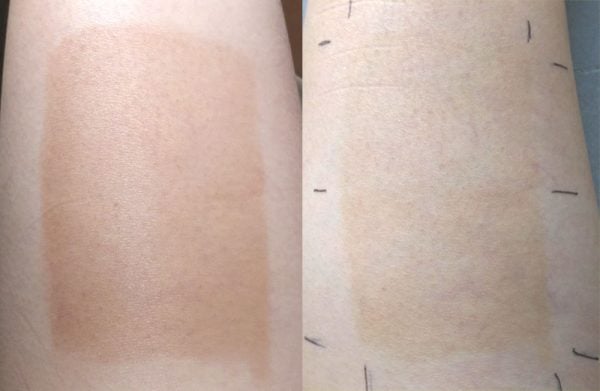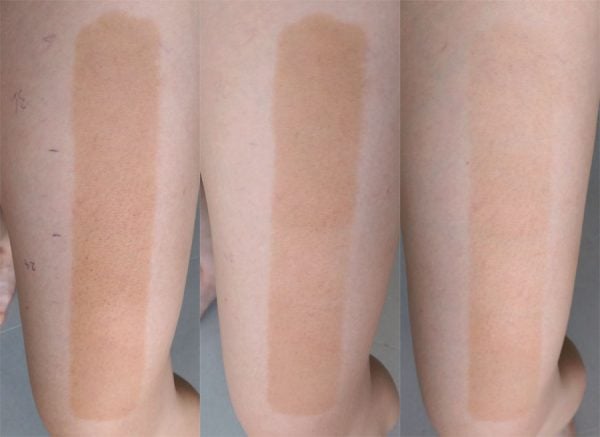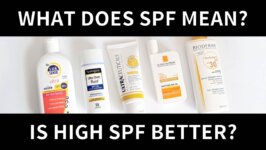If you’ve ever used fake tan, you’ll know that after a few days it can start to flake off, and if you’ve applied it unevenly you’ll want to buff out the stain ASAP.
I was pretty excited when I saw Bondi Sands Self Tan Eraser ($19.99 AUD for 200 mL). It’s a product that claims to remove fake tan – as someone who has had a lot of fake tan mishaps, I had to know whether it worked or not!

A quick refresher on how fake tan works, from my previous post on the topic (The Science of How Fake Tan Works): fake tan contains ingredients (usually dihydroxyacetone or DHA) which reacts with amino acids in the top layers of your skin to form a variety of brown compounds via a Maillard reaction over the next 1-3 days. This stains the top layers, and the tan slowly fades as your skin sheds (or desquamates, if you want to be fancy).
There are generally three types of tan removing product:
- Immediate removal: These are generally just cleanser, which washes away the fake tan before it has a chance to sink into the skin and react.
- Scrubs (physical exfoliants): This mechanically buffs away the dead skin cells faster than they would normally drop off. Unfortunately, this usually requires you to scrub your skin raw to really get rid of the tan.
- Chemical exfoliants: These loosen your dead skin cells and helps them come off faster than they normally would.
Bondi Sands Self Tan Eraser is in the third category. The (not so) secret ingredient in it, and most other similar chemical exfoliant fake tan removers, is urea. Urea is naturally present in your skin as part of the hydrating natural moisturising factor, and acts as a humectant moisturiser as well as a chemical exfoliant that helps loosen the top dead layers of your skin. Urea’s an ingredient that doesn’t get a lot of love, and it tends to be (in my opinion) massively underused in skincare products. It’s a bit more popular in Europe for some reason, and it’s in a few hardcore heel and hand creams like Du’it Tough Hands, PurSources Foot Cream and Eucerin Intensive Lotion.
Urea also has an unearned bad rep because there are a few preservatives with “urea” in their name (diazolidinyl urea, imidazolidinyl urea), and they can be allergens for some people. But much like how sodium chloride (table salt) is very different from sodium (silvery metal that bursts into flame when it touches water), these compounds and urea are very different, even if they have similar names. Plain old urea is a fantastic ingredient for sensitive skin, and you can find it in a whole bunch of dermatological treatments for irritation.
Bondi Sands Self Tan Eraser has urea as the second ingredient, as well as a bunch of moisturising ingredients. It also has a few other humectant moisturiser ingredients. It has a pH of 10, which is helpful for exfoliation because it makes the stratum corneum swell up, so it loosens and comes off more easily. The pH is a bit high for regular use, but it’s not a product that you’re meant to use all that often.
Ingredients: Water/Aqua/Eau, Urea, Ethoxydiglycol, Sodium Bicarbonate, Aloe Barbadensis Leaf Juice, Cocamidopropyl Betaine, PEG-40 Hydrogenated Castor Oil, Glycerin, Tetrasodium EDTA, Sodium Chloride, Fragrance (Parfum), Linalool, Potassium Sorbate, Sodium Benzoate
The product comes in a self-foaming pump bottle so it dispenses as a bubbly foam that’s easy to spread. You apply it to the areas where you need to remove tan, leave it on for about 5 minutes, then wash it off with warm water and a damp cloth (or an exfoliating mitt if it’s a bit stubborn).
Tan Remover In Action
It’s recommended that you use it on fake tan that’s at least 3 days old, so that was my first test. I applied a rectangle of fake tan (Bondi Sands Express Foam) to my leg, waited 3 days, then used the self tan eraser on half the rectangle. After waiting 5 minutes, I ran my leg under warm water and gently wiped over it a few times with a cloth. I then gently scrubbed the whole rectangle with an exfoliating mitt.
Photo on left: Rectangle of tan on Day 1 (24 hours after application, after washing).
Photo on right: Rectangle of tan on Day 3. Top half was treated with self tan eraser for 5 minutes, then entire rectangle was washed and gently scrubbed with an exfoliating mitt.

There was a noticeable difference in the colour. I didn’t try buffing super hard – my skin was a little pink afterwards, but not stinging. I’m pretty impressed with the result, and I think it would’ve completely come off in the part where I applied the tan eraser, if I scrubbed it a bit harder.
But I wasn’t entirely happy with the “3 day old tan” part, because if you really hate your tan you want it off ASAP. So I did another rectangle of tan on my other leg one evening, and waited 24 and 36 hours before trying to remove it with the tan eraser.
Photo on left: Rectangle of tan on Day 0.5 (12 hours after application, after washing). The 4 sections are marked on the left.
Photo in middle: Rectangle of tan on Day 1.5 (24 hour treatment). Second section from the bottom was treated with self tan eraser for 5 minutes, then bottom half of the rectangle was washed and gently scrubbed with an exfoliating mitt. The photo was taken around 12 hours after the scrubbing for consistent lighting.
Photo on right: Rectangle of tan on Day 2 (36 hour treatment). Top section was treated with self tan eraser for 5 minutes, then entire rectangle was washed and gently scrubbed with an exfoliating mitt.

There’s a noticeable difference both times with the tan eraser. It isn’t as effective as the 3 day treatment, but it will make it fade away faster.
Using a urea-based tan remover in combination with an exfoliating mitt is gentler and noticeably more effective than just using the mitt alone. Based on how fake tan works, it probably just isn’t possible to remove new tan this way – it’s sunken in too deep in the first few days, so you can’t get rid of the tan without going red raw until you wait for the top layers of skin to loosen. However, if you’re trying to get rid of flaky cracked tan that’s past its prime, then this product is great.
I also tried the tan eraser on a lipstick stain on my hand that I couldn’t get off – it worked really well. I suspect it’ll be fantastic for getting rid of other annoying skin stains too (permanent marker, vitamin C serum…).
Some other similar tan removers if you don’t have access to Bondi Sands where you are: Selfie Sunless Tan Remover, Cocoa Brown Fresh Start Tan Eraser, Tan-Luxe Glyco Water Self-Tan Eraser, Isle of Paradise Over It Magic Self-Tan Eraser, Vani-T Tan Eraser Mousse, St Moriz Professional Tan Remover. You can probably use other urea products (Du’it Tough Hands, PurSources Foot Cream etc.) in the same way as well.
This product was provided for editorial consideration, which did not affect my opinion. This post also contains affiliate links – if you decide to click through and support Lab Muffin financially (at no extra cost to you), thank you! For more information, see Disclosure Policy.






It’s very informative, thanks a lot! I thinks those removers a the thing this years since I see them often now. Great that they really work
Great review! I have used this product before and had good results but was curious about the ingredients. Thank you for the informative explanation! Amy x